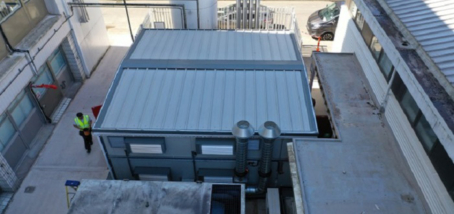-
BLACKOUT TECHNOLOGIES TARGETS TELEMATICS-INTEGRATED MOBILE DEVICE BLOCKING TO COMBAT SMARTPHONE DISTRACTION - April 1, 2025
-
OpenADR Alliance announces first OpenADR 3.0 certified products with EVoke Systems, E.ON Energy and Universal Devices - March 25, 2025
-
Growing fulfilment and contract packer appoints new Managing Director - March 25, 2025
-
When is it time to invest in a WMS? Understanding the key trigger points - March 25, 2025
-
eCapital helps Vantage Recruitment on its journey to financial success - March 24, 2025
-
Hugo Beck Celebrates 70 Years of Packaging Innovation with Open House Events - March 20, 2025
-
PROLOG FULFILMENT SUPPORTS LUNA DAILY’S COMMITMENT TO BETTER BODY CARE FOR ALL WOMEN - March 19, 2025
-
Motion Ventures launches largest-ever maritime tech fund at $100M to meet the industry’s new pace of adoption - March 18, 2025
-
ITD GLOBAL APPOINTS GROUP CHIEF REVENUE OFFICER - March 17, 2025
-
SURECAM TEAMS UP WITH ENTERPRISE FLEX-E-RENT FOR VEHICLE REPAIR & MAINTENANCE CONFERENCE - March 14, 2025
When a DSEAR* inspection at the chemistry department of a leading UK university recommended upgrading the site’s chemical storage facilities they turned to the hazardous materials experts Chemstore UK for a solution.
As a world leader in chemistry education with a reputation for cutting edge R&D the University of Warwick wanted a storage system to match so they asked Chemstore UK to create a completely new state-of-the-art flammable storage solution.
Special considerations
The DSEAR inspection identified that there was room for improvement in the way chemicals were segregated and bunded along with a need for better fire suppression in order to minimise the risks of fire and explosions. There were a number of special considerations that has to be taken into account when designing the storage solution:
- The university needed to be able to store and regularly access both virgin (manufactured sealed containers) and waste flammable products along with corrosives and packaging all within a fire rated and fire suppressed scenario. Products in use and waste containers are a particular area of concern because the original seal on these products has been broken which means vapours and fumes can occur. This is even more of a concern when these products are stored alongside combustible cardboard packaging because there is the potential for a fire to quickly take hold.
- There was restricted access to the site so the storage solution needed to be delivered in modules so it could be assembled on site
- A temporary safe storage solution was required to segregate and store chemicals safely while demolition work on the old unit was undertaken and the new unit was being built
General factors to consider when specifying a flammable store
A number of general factors also needed to be taken into consideration when specifying the flammable store.
For a fire to take place there needs to be a flammable vapour and a source of ignition. The best way to prevent vapours and fumes occurring is by storing products at the right temperature according to their Safety Data Sheet (SDS) within a temperature controlled unit. The unit should also include temperature monitoring so the operator is alerted if the temperature rises or falls outside of this range.
While prevention is better than cure it is still important to think about what would happen if a vapour occurs. Many flammable storage buildings have extraction options but care should be taken as to where the flammable vapour or hazardous fumes are extracted. Although it is surprisingly common practice, these vapours should not be pumped out of the rear of a building and forgotten about because if the vapour is heavier than air and an open drain is nearby it would, for example, only take a cigarette to be flicked into the drain for a fire to be started. A better solution is for the vapour be ducted out of the building and taken up to a high velocity cowl to disperse in the atmosphere.
Careful consideration must also be given to the extraction system including how many air changes are needed hourly and whether background extraction or lip extraction are most appropriate – for example during a dispensing process it is best to take vapour away at source? It is also worth noting that extraction systems are preferable to vents which rely on wind being present.
The worst case for a flammable storage building is a fire breaks out so it is also important to think about how this could occur, including removing all sources of ignition and considering whether static could build up during a dispensing process and therefore whether anti static flooring is required.
It is also necessary to plan for the eventuality that a fire breaks out and incorporate fire detection, ideally wired to a site’s BMS system, along with fire suppression to deal with the fire. Also, specifiers musn’t forget to consider what could happen to the store if it is affected by a fire that has broken out elsewhere.
The solution
Chemstore UK worked with the university to replace the existing brick built store with a bespoke walk in segregated fire rated store featuring an internal plant room.
The plant rooms contains: a double knock vesda fire detection system, Novec fire suppression, touch screen atex rated temperature control and O2 monitoring.
Meanwhile the main store comprises: an atex-rated lone worker alarm, atex purge extraction system to high velocity cowl (HVC), atex fire rated dampers, emergency lighting, chemical resistant anti-static altro flooring, a slide out bunded shelving and a packaging room where combustible cardboard can be kept ready for preparing product for onward shipment, a flammable waste room where product can be stored while kept in a temperature controlled/fire suppressed environment together with a purge extraction system that can be seen demonstrated here:
The main store also incorporates a segregated corrosives room to allow acids and alkalis to be stored separately along with a virgin material store with bunded slide out shelves for the storage of winchesters ready for despatch around campus.
The solution works like a shop whereby the university can pick what they need and it can be packaged and transported to a lab safely.
Chemstore UK also provided the university with three temporary stores they could use while their previous store was being demolished and ensured the new store was designed so that it could be assembled on site to overcome access restrictions.
Simon Watson, Head of Fire Safety, University of Warwick comments: “Chemstore UK has provided a remarkable level of knowledge and experience around hazardous materials storage which enabled them to come up with a market leading solution that precisely supported our needs. The Chemstore team were a pleasure to work with throughout the project and we are delighted with the results, which have transformed the way our Chemistry department operates and demonstrates the University’s commitment to high standards of health & safety.”
For more information about safely storing hazardous materials, contact Chemstore today on: Tel: 0208 704 1807 * DSEAR requires employers to assess the risks of fires and explosions that may be caused by dangerous substances in the workplace. From June 2015 DSEAR also covers the risk caused by gases under pressure and substances that are corrosive to metals.

































